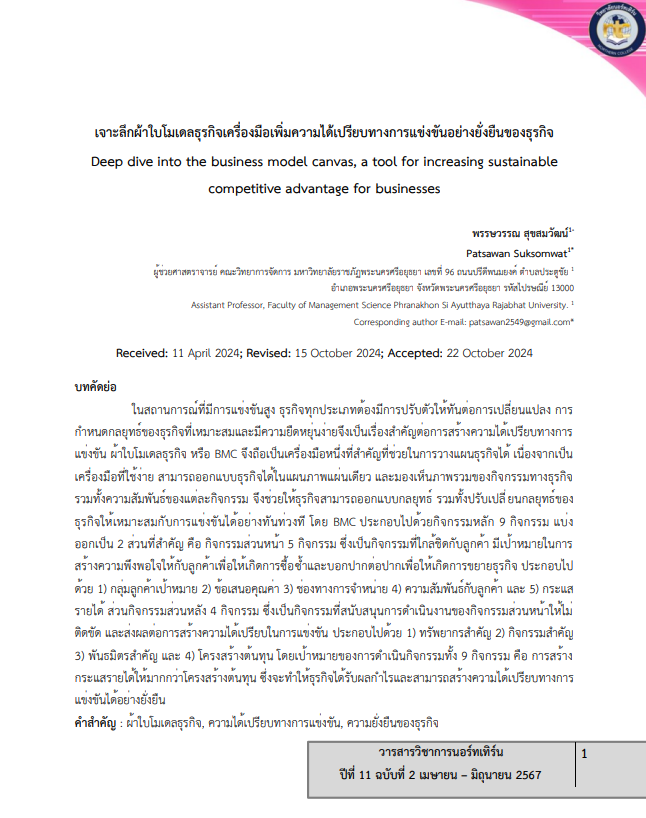Deep dive into the business model canvas, a tool for increasing sustainable competitive advantage for businesses
Keywords:
Business Model Canvas, Competitive Advantage, Business SustainabilityAbstract
In a highly competitive environment, businesses of all types must adapt to changes. Establishing appropriate and flexible business strategies is crucial for creating a competitive advantage. The Business Model Canvas (BMC) is an important tool that aids in business planning, as it is user-friendly and allows for the design of a business on a single diagram, providing an overview of business activities and the relationships between them. This helps businesses to design strategies and adjust their business strategies promptly to suit the competition. The BMC consists of nine key activities divided into two main parts: the front-end activities, which include five activities that are close to customers and aim to create customer satisfaction to encourage repeat purchases and word-of-mouth referrals for business expansion. These include: 1) Target customer segments, 2) Value propositions, 3) Distribution channels, 4) Customer relationships, and 5) Revenue streams. The back-end activities consist of four activities that support the smooth operation of the front-end activities and contribute to creating a competitive advantage. These include: 1) Key resources, 2) Key activities, 3) Key partners, and 4) Cost structure. The goal of conducting all nine activities is to generate revenue that exceeds the cost structure, which will enable the business to achieve profits and create a sustainable competitive advantage.
References
Daou, A., Mallta, C., Chammas, G., Cerantola, N., Kayed, S., and Saliba, N. A. (2020). The Ecocanvas as a business model canvas for a circular economy. Journal of Cleaner Production, 258, 1-12.
Keane, S. F., Cormican, K. T., and Sheahan, J. N. (2018). Comparing how entrepreneurs and managers represent the elements of the business model canvas. Journal of Business Venturing Insights, 9, 65-74.
Magretta, J. (2002). Why business models matter. Harvard Business Review, 80(5), 86-92.
Rytko¨nen, E., and Nenonen, S. (2014). The Business Model Canvas in university campus management. Intelligent Buildings International, 6(3), 138-154. Doi: doi.org/10.1080/17508975.2013.807768.
Sadikin, A., Naim, S., Asmara, M. A., Hierdawati, T., and Boari, Y. (2023). Innovative strategies for MSME business growth with the business model canvas approach. Enrichment: Journal of Management, 13(2), 1478-1484.
Toro-Jarrín, M. A., Ponce-Jaramillo, I. E., and Güemes-Castorena, D. (2016). Methodology for the of building process integration of Business Model Canvas and Technological Roadmap. Technological Forecasting & Social Change, 110, 213-225.
Umar, A., Sasongko, A. H., Aguzman, G., and Sugiharto. (2018). Business model canvas as a solution for Competing strategy of small business in INDONESIA. International Journal of Entrepreneurship, 22(1), 1-9.

Downloads
Published
How to Cite
Issue
Section
License

This work is licensed under a Creative Commons Attribution-NonCommercial-NoDerivatives 4.0 International License.






